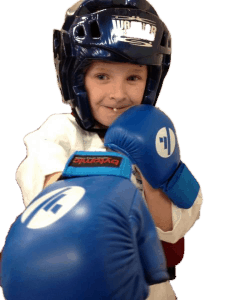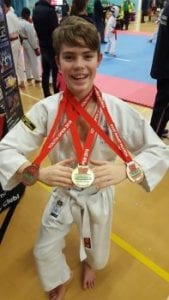Children’s development in the Martial Arts
This can be a contentious subject with many different views, the best proven by study, others by ‘gut feel.’ At our Basingstoke school for Martial Arts we take the view that kids aren’t simply small adults. Every child has to be treated differently and with knowledge about the best ways for them to learn a Martial Art, informed through proven Sports Science. Each of the areas covered in this article are short summaries of the topic and could be full length articles in their own right.
Development is not linear
The development of skills and talent itself in Martial Arts including Karate, Kickboxing or Judo is dynamic and not linear. We must recognise that at times, the appreciable skill level may seem to decrease, conversely there can be big jumps forward. Coaches responsible for child development should therefore incorporate this concept in their planning and delivery of lessons.
Many sports select children to play in age groups, often it’s the older children in each age group that are chosen, often resulting from their great maturity and size. This means that kids who mature later than their peers can miss out to those who mature earlier. Over time the physical advantages that a bigger older athlete has, will even out. Children’s development needs to be addressed with the differences between chronological/biological age understood and managed during training.
Concepts of Long Term Athlete Development
Balyi and Hamilton’s (2004) model of Long Term Athlete Development (LTAD) is predicated upon the belief that 10,000 hours of deliberate practice over 10 years is necessary to reach elite levels with a focus on chronological age and discrete activities/actions to be taken in a step-by-step process as one ages in order to reach full potential. This model is proscriptive and offers few options for diversity, for example the timing of when to start strength and conditioning training. LTAD identifies stages of optimal trainability where accelerated improvements can be made. However each stage has to be participated in sequentially.

There are gender differences in terms of maturation, as a generalisation, with girls reaching puberty around 12 years old and boys 14 years old. Maturation can occur 4/6 or more years before/after these ages. In sports, initially at least, early maturers can have a significant advantage over later maturers. Physiological changes around the puberty years can tremendously affect the physical abilities of each individual.
Whilst the research clearly demonstrates that it the 10,000 hour isn’t necessarily correct. What is clearly shown is that the more deliberate practice one does in any physical activity, indeed in any activity or endeavour the better the outcome for the practitioner in terms of the quality and repeatability of their skills.
Fundamental Movement Skills
Individual and gender specific training considerations must be considered. How and when to start with fundamental movement skills and strength and conditioning to ensure that they have the functional skills and knowledge to take part in sport and then learn the sports specific skills.
At an young age we work with our 4 – 6 years old to help them to learn fundamental movement with their Karate. Judo and Kickboxing skills. At this age, if they are equipped to run, jump, skip, hop, throw, catch and kick, then they learn to balance and develop co-ordination. After this playing all sports becomes much easier. Social skills are just as important and learning focus, discipline, memory, control and teamwork will again set them up for the long term.
From 6 – 9 years old, there is a period where the child makes accelerated progress in speed, mobility, agility, strength, power and endurance. Skills can be built and developed to take into account these factors. However consideration has to be given that often, children through their time spent on electronic devices may not have the fundamental movement skills to progress through their chosen sport.
Therefore it is necessary to have a structured plan to maximise the talent of the individual, with the explicit knowledge that everyone’s talent is different, whilst planning for long term physical fitness, health and well-being, both physical and mental. This plan significantly changes throughout our lives as we grow, age and mature.
Nutrition
Nutrition is often a thorny subject, particularly if a child is a ‘picky eater.’ Children’s nutritional and calorific requirements can be complex, they need sufficient calorific intake to fuel their bodies and growth along with the additional requirements to fuel their physical exercise. Hydration is a key aspect with a 2% drop in adult’s and 1% in children’s hydration causing upto a 25% decrease in their ability to take part in physical exercise. There are still many combat sports that advocate dehydration as a strategy to make weight for an event. This can cause health issues for their practitioner, so more sustainable ways should be considered. Water is a great option for re-hydration as is milk, which also provides many macro nutrient benefits when it is drunk. Carbonated drinks are not such a great choice to use for re-hydration.
Strength and Conditioning
Earlier we touched upon sport specific skills, in considering these we need take into account the requirements of each Martial Art before undertaking Strength and Conditioning training. A child learning Judo has very different strength and speed requirements than a child learning Karate. Methods for maximising speed and acceleration differ between Martial Arts. Broadly Judo requires the ability to move one’s opponent and self whilst maintaining stability of mass and joints. Therefore strength training in Judo should develop power and strength with the focus of throwing an opponent. Karate, differs, in that it relies on speed of one’s own movement against a resisting opponent. Clearly still a strength and power requirement to Karate, but their needs to be more of a focus on acceleration of the body.
There is a misconception that strength training isn’t for females. This is a fallacy, functional strength and conditioning training is necessary for all ‘sportspeople’ and Martial Artists.
Summary
Child development takes place at various rates and at different times, like adults, they are all individuals, treat them as such.
The more practice/deliberate play time a child gets, the better they are likelier to become at their chosen Martial Art.
Fundamental movement skills are a necessity before focusing on sport specific skills.
Fuel the body and mind to become and stay a successful Martial Artist.



